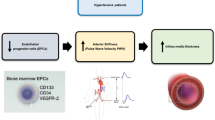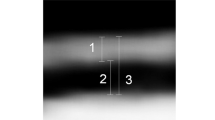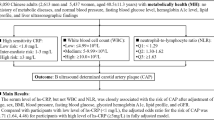Abstract
Carotid artery intima-media thickness (IMT) is a widely accepted index for assessing atherosclerosis, and is known to be a risk indicator for cardiovascular and cerebrovascular events. Oxidative stress and inflammation are also known to play critical roles in the pathogenesis of vascular events. We studied the association between IMT and inflammatory markers, such as oxidative stress in polymorphonuclear leukocytes (PMNs) and mononuclear cells (MNCs) in 156 patients with essential hypertension. Reactive oxygen species (ROS) formation by PMNs and MNCs was measured by gated flow cytometry. CRP and traditional risk factors, such as age, gender, body mass index, hemoglobin A1c, and total cholesterol were also measured. The subjects were divided into a plaque group (max-IMT⩾1.1 mm, n=40), and a nonplaque group (max-IMT<1.1 mm, n=116). ROS formation by MNCs was significantly increased in the plaque group when compared with the nonplaque group (P<0.0001). Multiple regression analysis revealed a significant correlation between IMT and ROS formation by MNCs (r=0.407, P<0.0001), or CRP (r=0.216, P=0.0029) or hemoglobinA1c (r=0.158, P=0.0270) or age (r=0.157, P=0.0447). No significant correlation was observed between IMT and ROS formation by PMNs. These results suggest that carotid artery IMT may be affected by increased ROS formation by MNCs, and that increased ROS formation by MNCs may be related to the development of atherosclerosis. We propose that ROS formation by MNCs is a marker for prediction of carotid atherosclerosis.
This is a preview of subscription content, access via your institution
Access options
Subscribe to this journal
Receive 12 digital issues and online access to articles
$119.00 per year
only $9.92 per issue
Buy this article
- Purchase on Springer Link
- Instant access to full article PDF
Prices may be subject to local taxes which are calculated during checkout


Similar content being viewed by others
References
Smith Jr SC, Greenland P, Grundy SM . Prevention conference V: beyond secondary prevention: identifying the high-risk patient for primary prevention. Circulation 2000; 101: 111–116.
O’Leary DH, Polak JF . Intima-media thickness: a tool for atherosclerosis imaging and event prediction. Am J Cardiol 2002; 90: 18–21.
Chambless LE, Heiss G, Folsom AR, Rosamond W, Szklo M, Sharrett AR et al. Association of coronary heart disease incidence with carotid arterial wall thickness and major risk factors: the Atherosclerosis Risk in Communities (ARIC) Study, 1987–1993. Am J Epidemiol 1997; 146: 483–494.
Harrison D, Griendling KK, Landmesser U, Hornig B, Drexler H . Role of oxidative stress in atherosclerosis. Am J Cardiol 2003; 91: 7A–11A.
Ross R . Atherosclerosis: an inflammatory disease. N Engl J Med 1999; 340: 115–126.
Yasunari K, Maeda K, Nakamura M, Yoshikawa J . Oxidative stress in leukocytes is a possible link between blood pressure, blood glucose, and C-reacting protein. Hypertension 2002; 39: 777–780.
Sesso HD, Buring JE, Rifai N, Blake GJ, Gaziano JM, Ridker PM . C-reactive protein and the risk of developing hypertension. JAMA 2003; 290: 3000–3002.
Sung KC, Suh JY, Kim BS, Kang JH, Kim H, Lee MH et al. High sensitivity C-reactive protein as independent risk factor for essential hypertension. Am J Hypertension 2003; 16: 429–433.
Dorffel Y, Latsch C, Stuhlmuller B, Schreiber S, Scholze S . Preactivated peripheral blood monocytes in patients with essential hypertension. Hypertension 1999; 34: 113–117.
Mehta JL, Lopes LM, Chen L, Cox OE . Alterations in nitric oxide synthase activity, superoxide anion generation, and platelet aggregation in systemic hypertension, and effect of celiprolol. Am J Cardiol 1994; 74: 901–905.
Pontremoli S, Salamino F, Sparatore B, De Tullio R, Patrone M, Tizianello A . Enhanced activation of the respiratory burst oxidase in neutrophils from hypertensive patients. Biochem Biophys Res Commun 1989; 158: 966–972.
Alexander RW . The Jeremiah Metzger Lecture. Pathogenesis of atherosclerosis: redox as a unifying mechanism. Trans Am Clin Climatol Assoc 2003; 114: 273–304.
Smedly LA, Tonnesen MG, Sandhaus RA, Haslett C, Guthrie LA, Johnston Jr RB et al. Neutrophil-mediated injury to endothelial cells: enhancement by endotoxin and essential role of neutrophil elastase. J Clin Invest 1986; 77: 1233–1243.
Weiss SJ . Tissue destruction by neutrophils. N Engl J Med 1989; 320: 365–376.
Jialal I, Devaraj S, Kaul N . The effect of α-tocopherol on monocyte proatherogenic activity. J Nutr 2001; 131: 389–394.
Danton GH, Dietrich WD . Inflammatory mechanisms after ischemia and stroke. J Neuropathol Exp Neurol 2003; 62: 127–136.
Bass DA, Parce JW, Dechatelet LR, Szejda P, Seeds MC, Thomas M . Flow cytometric studies of oxidative product formation by neutrophils: a graded response to membrane stimulation. J Immunol 1983; 130: 1910–1917.
Yasunari K, Kohno M, Kano H, Minami M, Yokokawa K, Yoshikawa J . Antioxidants improve impaired insulin-mediated glucose uptake and prevent migration and proliferation of cultured rabbit coronary smooth muscle cells induced by high glucose. Circulation 1999; 99: 1370–1378.
Yasunari K, Maeda K, Watanabe T, Nakamura M, Yoshikawa J, Asada A . Comparative effects of valsartan versus amlodipine on left ventricular mass and reactive oxygen species formation by monocytes in hypertensive patients with left ventricular hypertrophy. J Am Coll Cardiol 2004; 43: 2116–2123.
Yasunari K, Maeda K, Nakamura M, Watanabe T, Yoshikawa J, Asada A . Effects of carvedilol on oxidative stress in polymorphonuclear and mononuclear cells in patients with essential hypertension. Am J Med 2004; 116: 460–465.
Takiuchi S, Kamide K, Miwa Y, Tomiyama M, Yoshii M, Matayoshi T et al. Diagnostic value of carotid intima-media thickness and plaque score for predicting target organ damage in patients with essential hypertension. J Hum Hypertens 2004; 18: 17–23.
Hashimoto H, Kitagawa K, Hougaku H, Etani H, Hori M . Relationship between C-reactive protein and progression of early carotid atherosclerosis in hypertensive subjects. Stroke 2004; 35: 1625–1630.
Zheng Z, Lee JE, Yenari MA . Stroke: molecular mechanisms and potential targets for treatment. Curr Mol Med 2003; 3: 361–372.
Beray-Berthat V, Palmer B, Plotkine M, Margaill I . Neutrophils do not contribute to infarction, oxidative stress, and NO synthase activity in severe brain ischemia. Exp Neurol 2003; 182: 446–454.
Lerouet D, Beray-Berthat V, Palmier B, Plotkine M, Margaill I . Changes in oxidative stress, iNOS activity and neutrophil infiltration in severe transient focal cerebral ischemia in rats. Brain Res 2002; 958: 166–175.
Rausch M, Sauter A, Frohlich J, Neubacher U, Radu EW, Rudin M . Dynamic patterns of USPIO enhancement can be observed in macrophages after ischemic brain damage. Magn Reson Med 2001; 46: 1018–1022.
Maeda K, Yasunari K, Watanabe T, Nakamura M . Oxidative stress by periheral blood mononuclear cells is increased in hypertensives with an extreme-dipper pattern and/or morning surge in blood pressure. Hypertens Res 2005; 28: 755–761.
Pasceri V, Willerson JT, Yeh ETH . Direct proinflammatory effect of C-reactive protein on human endothelial cells. Circulation 2000; 102: 2165–2168.
Cao JJ, Thach C, Manolio TA, Psaty BM, Kuller LH, Chaves PH et al. C-reactive protein, carotid intima-media thickness, and incidence of ischemic stroke in the elderly: the Cardiovascular Health Study. Circulation 2003; 108: 166–170.
Acknowledgements
We thank Yukiko Tainaka, Sayuri Takagi and Aiko Hamada for excellent secretarial assistance.
Author information
Authors and Affiliations
Corresponding author
Rights and permissions
About this article
Cite this article
Watanabe, T., Yasunari, K., Nakamura, M. et al. Carotid artery intima-media thickness and reactive oxygen species formation by monocytes in hypertensive patients. J Hum Hypertens 20, 336–340 (2006). https://doi.org/10.1038/sj.jhh.1001990
Received:
Revised:
Accepted:
Published:
Issue Date:
DOI: https://doi.org/10.1038/sj.jhh.1001990
Keywords
This article is cited by
-
Sarcoidosis exosomes stimulate monocytes to produce pro-inflammatory cytokines and CCL2
Scientific Reports (2020)
-
Reactive Oxygen Species Imaging in a Mouse Model of Inflammatory Bowel Disease
Molecular Imaging and Biology (2016)
-
Oxidative stress in hypertensive children before and after 1 year of antihypertensive therapy
Pediatric Nephrology (2012)
-
Superoxide dismutase type 1 in monocytes of chronic kidney disease patients
Amino Acids (2011)
-
New insights into complement C3 and inflammation in hypertension
Journal of Human Hypertension (2007)



